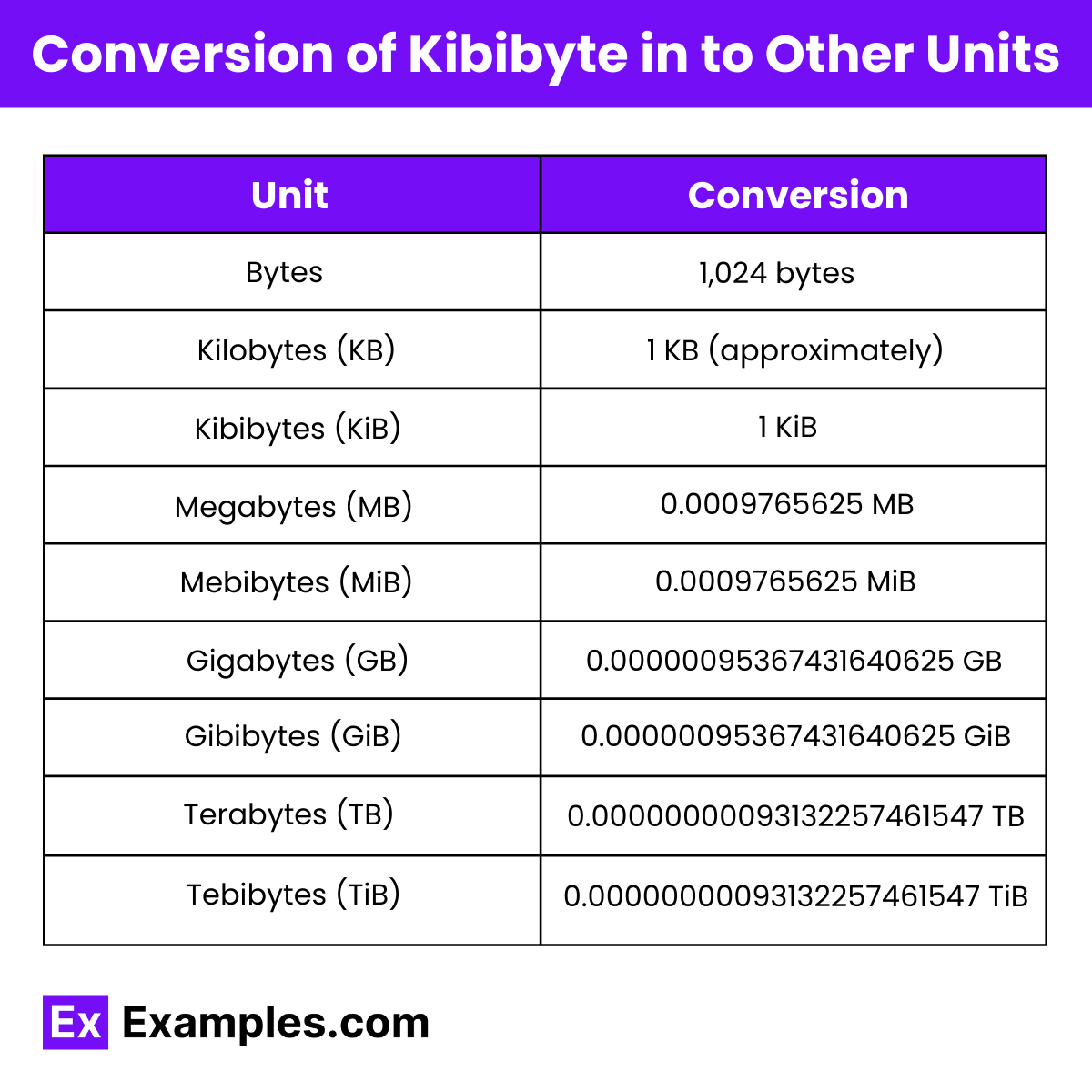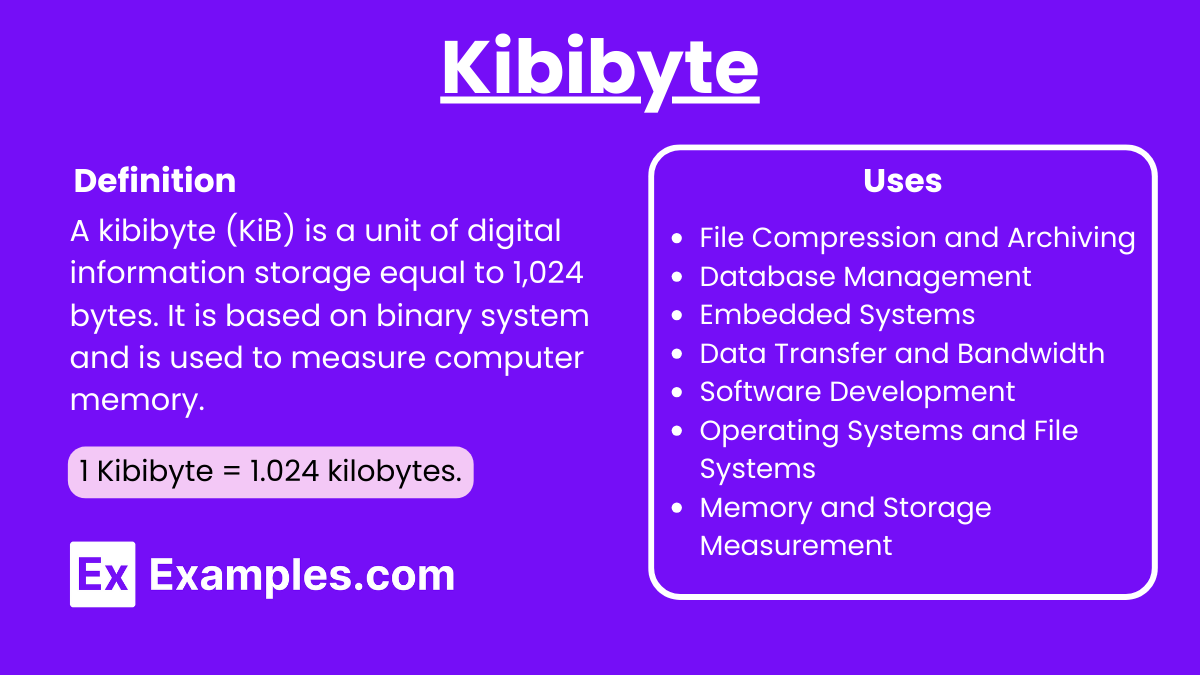Kibibyte – 50 Examples, Uses, Applications, Differences
A kibibyte (KiB) is a unit of digital information storage that equals 1,024 bytes. It is commonly used in cloud computing, where precise data measurement is essential for managing storage resources. In the realm of digital communication, kibibytes help in accurately defining data transfer rates and storage capacities. As communication technology advances, understanding units like the kibibyte becomes increasingly important for efficient data management and processing.
What is Kibibyte?
A kibibyte (KiB) is a unit of digital information storage equal to 1,024 bytes. It is used to measure data capacity and transfer rates in computing and communication technology.
Examples of Kibibyte
- A short text email without attachments.
- A few paragraphs of a text document.
- A small icon image file (e.g., .ico format).
- The size of a small HTML webpage.
- A simple spreadsheet file.
- A basic configuration file for software.
- A tiny JSON data file.
- A simple CSS file for web styling.
- A short Python script.
- A small JavaScript file.
- A brief README.txt file.
- A low-resolution, small-sized image (e.g., .jpg or .png).
- A short piece of MIDI music file.
- A basic font file.
- A small chunk of binary data.
- A small log file.
- A simple, single-page PDF document.
- A basic XML file.
- A small bookmark file for a web browser.
- A tiny database file (e.g., SQLite with minimal data).
- A small, plain text configuration file.
- A small batch script.
- A short, compiled program in machine code.
- A minimalistic JSON configuration file.
- A small text-based dataset.
- A small INI file.
- A short C program source code file.
- A small vector graphic file (e.g., .svg).
- A small user manual in plain text.
- A brief changelog file.
- A small YAML configuration file.
- A short SQL script.
- A simple Markdown file.
- A basic network configuration file.
- A small script for automation.
- A small Java class file.
- A short Ruby script.
- A small assembly language source file.
- A brief CSS stylesheet.
- A small bash script.
- A short Perl script.
- A minimalistic HTML template.
- A small Lua script.
- A brief configuration file for an application.
- A small log from a system process.
- A simple .htaccess file for web servers.
- A small piece of binary executable.
- A short configuration file for a server.
- A small firmware update file.
- A small chunk of encrypted data.
What are Kibibyte used for?
Binary vs. Decimal System Comparison
| Binary Prefix | Value in Bytes | Decimal Prefix | Value in Bytes |
|---|---|---|---|
| 1 kibibyte (KiB) | 1,024 bytes | 1 kilobyte (KB) | 1,000 bytes |
| 1 mebibyte (MiB) | 1,048,576 bytes | 1 megabyte (MB) | 1,000,000 bytes |
| 1 gibibyte (GiB) | 1,073,741,824 bytes | 1 gigabyte (GB) | 1,000,000,000 bytes |
1. Memory and Storage Measurement
Kibibytes are often used to measure smaller units of memory and storage capacity, providing a more precise calculation for computer systems:
- Cache Memory: Describing small memory caches in processors.
- Disk Sectors: Measuring sectors and blocks in file systems.
2. Operating Systems and File Systems
Operating systems and file systems frequently use binary prefixes to display file sizes and storage capacities. Examples include:
- File Size: Displaying smaller file sizes in KiB for accuracy.
- Disk Usage: Reporting disk usage for directories and files in kibibytes.
3. Software Development
Developers use kibibytes for memory allocation and buffer sizes, especially in system-level programming and optimization:
- Buffer Sizes: Setting buffer sizes for file I/O operations.
- Memory Allocation: Allocating small chunks of memory for data structures.
4. Data Transfer and Bandwidth
In networking and data transfer contexts, kibibytes are used to measure data packets and transfer rates:
- Data Packets: Measuring packet sizes in KiB.
- Transfer Rates: Reporting bandwidth usage in KiB/s (kibibytes per second).
5. Embedded Systems
In embedded systems, where memory resources are often limited, kibibytes are used to specify memory and storage capacities:
- Firmware Storage: Measuring the size of firmware stored in ROM.
- Memory Constraints: Specifying RAM sizes in small embedded devices.
6. Database Management
Databases use kibibytes to manage smaller data chunks and optimize performance:
- Record Sizes: Reporting the size of individual records or rows.
- Index Sizes: Measuring the size of database indexes.
7. File Compression and Archiving
File compression tools and archiving utilities display file sizes and compression ratios in kibibytes:
- Compressed Files: Showing the size of compressed files in KiB.
- Archiving Tools: Reporting the total size of files in an archive in kibibytes.
Converting Kibibyte in to Other Units of Data
| Unit | Value |
|---|---|
| Bits | 8,192 bits |
| Bytes | 1,024 bytes |
| Kilobytes (KB) | 1 KB (approximately) |
| Kibibytes (KiB) | 1 KiB |
| Megabytes (MB) | 0.0009765625 MB |
| Mebibytes (MiB) | 0.0009765625 MiB |
| Gigabytes (GB) | 0.00000095367431640625 GB |
| Gibibytes (GiB) | 0.00000095367431640625 GiB |
| Terabytes (TB) | 0.0000000009313225746154785 TB |
| Tebibytes (TiB) | 0.0000000009313225746154785 TiB |
| Petabytes (PB) | 0.0000000000009094947017729282 PB |
| Pebibytes (PiB) | 0.0000000000009094947017729282 PiB |
Applications of Kibibyte
File Storage and Memory
Text Files: Small text documents, such as configuration files, scripts, and log files, are often measured in kibibytes.
Example: A typical plain text file containing a few pages of text might be around 2-3 KiB.
Small Images: Low-resolution images, like icons and thumbnails, are often sized in kibibytes.
Example: A 32 x 32 pixel PNG icon might be around 1-2 KiB.
Documents: Simple documents, such as memos or short reports, especially in plain text or basic formats.
Example: A plain text document or a small HTML file for a webpage.
System and Software
Configuration Files: Many software applications and operating systems use small configuration files to store settings.
Example: A configuration file for a software application might be 4-5 KiB.
Boot Files: Some system boot files, essential for starting the operating system, can be in the range of a few kibibytes.
Example: Boot sector files or initial program loaders.
Firmware: Basic firmware for simple devices can be sized in kibibytes.
Example: Firmware for small embedded systems or microcontrollers.
Networking
Data Packets: Data packets transmitted over networks can be in the kibibyte range, especially in protocols with small payload sizes.
Example: An Ethernet frame with a payload might be around 1.5 KiB.
Email Attachments: Small attachments in emails, like text documents or simple images, often fall into the kibibyte range.
Example: An email with a small image attachment.
Software Development
Source Code Files: Individual source code files for programs and scripts are often measured in kibibytes.
Example: A single Python or C source code file.
Compiled Executables: Small executable files, such as those for simple utilities or embedded systems, can be in the kibibyte range.
Example: A small compiled binary for a microcontroller.
Difference Between Kibibyte and Kilobyte

| Feature | Kibibyte (KiB) | Kilobyte (KB) |
|---|---|---|
| Definition | A unit of digital information equal to 1024 bytes | A unit of digital information equal to 1000 bytes |
| Symbol | KiB | KB |
| Binary Prefix | Yes | No |
| Decimal Prefix | No | Yes |
| Usage | Used primarily in computing contexts where binary multiples are needed | Used in general contexts, especially in data storage and file sizes |
| Bytes Equivalent | 1 KiB = 1024 bytes | 1 KB = 1000 bytes |
| Calculation Base | Based on powers of 2 | Based on powers of 10 |
| Origin | International Electrotechnical Commission (IEC) | International System of Units (SI) |
| Common Application | Memory size in computers | Disk storage, file size, and general usage |
| Example | 1 KiB = 1024 bytes, 2 KiB = 2048 bytes | 1 KB = 1000 bytes, 2 KB = 2000 bytes |
How does a Kibibyte relate to a Kilobyte?
Unlike the decimal Kilobyte (1000 bytes), a Kibibyte equals 1024 bytes.
Why use Kibibyte over Kilobyte?
Kibibyte accurately represents data in binary systems used in electromagnetism and computing.
Is Kibibyte used in storage devices?
Yes, Kibibytes are commonly used in RAM and other binary-based storage.
How does a Kibibyte fit into data hierarchy?
A Kibibyte is larger than a byte and smaller than a Megabyte.
Are Kibibytes important in cloud computing?
Yes, especially in PaaS where precise data measurement is critical.
Can Kibibytes be converted to Kilobytes?
Yes, but note the difference: 1 Kibibyte is 1024 bytes, 1 Kilobyte is 1000 bytes.
Do all operating systems use Kibibytes?
Most modern OSs use Kibibytes for memory and storage management.
Are Kibibytes relevant in electromagnetism?
They can be, particularly in the digital representation of data related to electromagnetism.
What industries use Kibibytes?
Computing, telecommunications, and any industry involving digital data storage.
Do Kibibytes appear in software documentation?
Yes, particularly in technical and binary data contexts.


